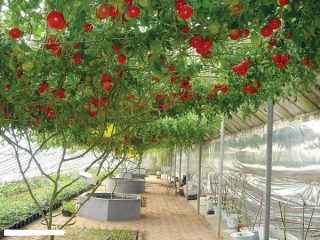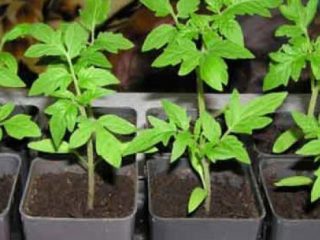Content
The choice of tomato variety for planting depends on several determining factors. For the northern regions, hybrids with high frost resistance are suitable; for the southern regions of the country, yield indicators are taken as a basis. There are tomatoes that meet almost all the requirements. The Windrose tomato is one of the species that is distinguished by its unpretentiousness, productivity and high adaptive abilities.
Description of the tomato variety Windrose
The Wind Rose variety was bred by Russian scientists with the aim of obtaining a hybrid capable of growing in the northern regions of the country. It was included in the State Register of the Russian Federation in the spring of 2003 with recommendations for cultivation in any chosen method: in greenhouses, on open ground or under the film of mini-greenhouses.
- The tomato bush of the Wind Rose variety grows up to 45 cm, it is classified as an erect species, so the formation is carried out in several stems.
- The leaves of the plant are narrow, light green with corrugated edges and light edges. The variety is prone to active growth of green mass, so there are always a lot of leaves on the bush.
- The flowers appear as the ovaries form; they are small and pale pink.
- The fruits of this variety have a smooth, round shape with a small depression in the area of the stalk.
Wind rose is classified as an early ripening variety. According to the structure of the stems, Windrose tomatoes belong to determinate hybrids.
Description of fruits
The main value of the variety is its smooth, blemish-free fruits. Based on the description of tomatoes of the Windrose variety, the main characteristics were compiled:
- average fruit weight – 130 g;
- the skin is thin but dense;
- the surface is glossy, without growths;
- the shade varies from pink to dark pink;
- the pulp is juicy;
- the taste is classified as sweet-spicy;
- the number of seeds is minimal.
The hybrid Windrose is classified as a salad species: this means that their main area of application is their fresh consumption. According to numerous reviews about the Windrose tomato variety, it is perfect for pickling and preparing assorted preparations, where several vegetable crops are mixed.
Main characteristics
Wind rose is popular with those who grow tomatoes in open ground using seedlings, as well as with those who prefer greenhouse cultivation. The yield of the variety remains stable when choosing any method. This is one of the many advantages of the hybrid.
The main characteristic features of Windrose tomatoes are considered to be the following:
- To achieve technical ripeness, tomatoes require about 95 days from the moment seedlings emerge;
- if the minimum requirements are met, the bushes bear fruit consistently for several weeks;
- the variety is resistant to low temperatures;
- adapts to unstable climatic conditions;
- can be grown in greenhouse beds and in open ground;
- Due to the compactness of the bushes, the crop can grow in small areas.
According to reviews from summer residents, under favorable conditions and following the basic rules for caring for 1 sq. m of plantings, about 7 kg of fruits are collected per season.
When planting the determinate variety Windrose, no additional supports are required, since the bushes are low and can support the weight of the fruit without the risk of sagging to the ground.
The hybrid is characterized as resistant to many major tomato diseases: this is explained by its high adaptive and protective indicators, as well as its belonging to the early ripening type. The active phase of the growing season occurs during a time period when favorable conditions for the development of diseases characteristic of the crop have not occurred.
Advantages and disadvantages
Based on reviews of the Windrose tomato variety, we can conclude that the hybrid has almost no drawbacks.
If we are talking about the advantages of a variety, then its main characteristics are information about high yield, resistance to changing climatic conditions and excellent taste of the fruit.
If they talk about the shortcomings of the variety, they mention the need to add additional mineral complexes to the bushes in order to improve the quality of the soil. This measure can increase yields.
Rules for planting and care
Seeds for seedlings of the Wind Rose variety begin to be sown in late March - early April. This period is suitable for planning planting in the ground during the first week of June. Recommendations for care and planting:
- carrying out soil disinfection;
- step-by-step seed preparation;
- additional fertilizer with mineral mixtures;
- choosing a site with neighbors suitable for the culture.
Growing seedlings
Seeds of the Windrose variety must be placed in a root biostimulator. This rule applies to all early ripening varieties of tomatoes. After soaking for 12 hours, dry them at room temperature. If necessary, the seeds are processed additionally:
- hardening (recommended for northern regions);
- germination (when planting a small number of seedlings in order to exclude the admission of non-viable material to sowing);
- calibration (for screening out empty seeds).
The soil for sowing is hardened or calcined. It depends on the individual preferences of the summer resident. To warm up, the soil is placed in an oven and kept at a temperature of +70 °C.
For hardening, it is frozen at -10 °C 2 - 3 days before sowing.
The Wind Rose variety is usually sown in common containers, and after germination and the appearance of the 3rd - 4th leaf, picking is carried out. Weak sprouts are left on the windowsill at a temperature of +22 - 24 °C and a stable supply of sunlight. Strong seedlings begin to be prepared for planting in a permanent place of growth.
Transplanting seedlings
Seedlings are transplanted as the soil is prepared:
- for greenhouse cultivation, plantings are planned for early to mid-May, provided the soil warms up to +18 °C;
- for mini-greenhouses, choose a period when the possibility of return frosts is excluded;
- for open ground, the timing may shift depending on climatic conditions, however, the open soil must be warmed up to at least +15 °C.
The soil is dug up 1 week before planting. Organic plants are added.When planting, mineral fertilizers are applied. Those who planted the Wind Rose on their plot recommend adding a bucket of hot water to the hole before planting. This method helps the sprouts adapt faster and withstand temperature changes without energy costs.
Mini-greenhouses are additionally covered with plastic film, since greenhouse plantings are carried out earlier than plantings in open soil, which means that the age of the seedlings requires additional care.
For planting, the size of the bushes is taken into account. According to the manufacturer's recommendations, each sprout is planted at a distance of 35 - 40 cm from the other. The distance between the rows is up to 60 cm. This scheme will allow garters, pinching and harvesting to be carried out unhindered.
Tomato care
Windrose tomatoes require regular weekly watering. They are able to tolerate periods of short-term drought and calmly respond to slight waterlogging, but violation of watering rules immediately affects the yield.
For feeding, mineral complexes with potassium and phosphorus are used. Liquid mixtures are applied at the root every 2 weeks. This is not a prerequisite, but can help increase yields.
To get rid of weed and prevent the appearance of insects, tomatoes of this variety are mulched immediately after planting.Sawdust and pine needles are suitable for mulching.
The bushes do not need pinching: due to their short stature, bush formation is not practiced. In order for the bush to withstand the weight of the formed tomatoes, several garters are made.
Conclusion
The Windrose tomato has almost no drawbacks. With low demands, it gives an excellent harvest. The taste of the fruit has made this variety especially popular in recent decades.















